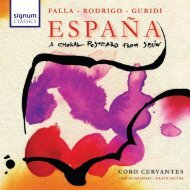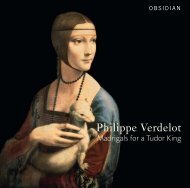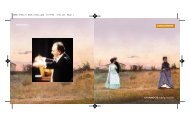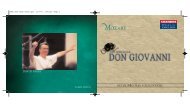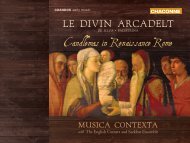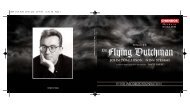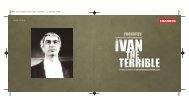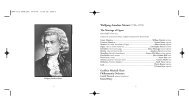TRUMPET COLLECTION - Chandos
TRUMPET COLLECTION - Chandos
TRUMPET COLLECTION - Chandos
Create successful ePaper yourself
Turn your PDF publications into a flip-book with our unique Google optimized e-Paper software.
Some of our SAYDISC unusual, traditional & exotic albums and AMON RA authentic performances on<br />
original instruments. Visit www.saydisc.com or write for more details and suppliers:<br />
CD-SDL 325 Like Waves Against The Sand - trad music from China - pipa, erhu, yanqin, percussion<br />
CD-SDL 327 Enchanted Carols - musical boxes, handbells, handbell choir, street pianos, brass band<br />
CD-SDL 333 Ringing Clear - Handbell tune and change ringing in various styles<br />
CD-SDL 343 On Kielder Side - Northumbrian Pipe music from Kathryn Tickell<br />
CD-SDL 353 Fleur Du Jura - Parisian style cafe music from Danielle Pauly - French accordion Queen<br />
CD-SDL 358 Keep The Home Fires Burning - music of the 1st World War from the original recordings<br />
CD-SDL 360 Under The Greenwood Tree - Carols and dances from Thomas Hardy manuscripts, etc<br />
CD-SDL 367 Kurokami- Traditional music of Japan -koto/shakuhachi/shamisen<br />
CD-SDL 373 Music From The Time Of The Spanish Armada -The York Waits renaissance town band<br />
CD-SDL 374 The Music Of The Hurdy Gurdy - Nigel Eaton & friends—bourreés to Vivaldi<br />
CD-SDL 376 Disappearing World - Unique recordings of music from 17 endangered cultures<br />
CD-SDL 378 Church Bells Of England - 16 famous peals, Cotswolds, Bristol incl. St. Pauls, Westminster<br />
CD-SDL 383 Sing Lustily & With Good Courage - Favourite 18th c. hymns - Maddy Prior/ Carnival Band<br />
CD-SDL 387 Traditional Arabic Music - Hassan Erraji with Arabesque - ud, nay, saz, darbouka, bandir, etc<br />
CD-SDL 388 Music Of the Andes - Caliche - pan-pipes, charango, quena, bombo drum, etc<br />
CD-SDL 391 Traditional Songs of Scotland - Ray Fisher with bagpipe, violin, accordion etc<br />
CD-SDL 393 English Country Dances - The Broadside Band - favourite Playford dances<br />
CD-SDL 396 Vocal Traditions of Bulgaria - exciting music from the Archives of Radio Sofia<br />
CD-SDL 400 English National Songs - Lucie Skeaping & John Potter with The Broadside Band<br />
CD-SDL 402 Traditional Songs of England - Jo Freya with fiddles, concertina, hurdy-gurdy, viols, etc<br />
CD-SDL 403 Spirit of Polynesia - The David Fanshawe trilogy of traditional Pacific music, volume 1<br />
CD-SDL 405 Sea Songs & Shanties - from the last days of sail -Bob Roberts, Cadgwith Fishermen, etc<br />
CD-SDL 406 Traditional Songs of Wales - Siwsann George with Welsh triple harp, crwth, hurdy-gurdy, etc<br />
CD-SDL 408 The Victorian Musical Box - numerous rare disc and cylinder musical boxes<br />
CD-SDL 409 Songs and Dances From Shakespeare - The Broadside Band and singers<br />
CD-SDL 413 Cockney Kings of Music Hall - the original recordings<br />
CD-SDL 417 A Celtic Christmas - from Wales, Scotland, Ireland, Isle of Man, Cornwall and Britanny<br />
CD-SDL 419 Old English Nursery Rhymes - Vivien Ellis / Tim Laycock and The Broadside Band<br />
CD-SDL 422 Compline & Other Chant: Latin & English, nuns of Stanbrook/monks of Prinknash Abbeys<br />
CD-SDL 427 Folk Music of Tibet - field recordings of songs and instrumental music<br />
CD-SDL 429 Carillon Bells of Britain - Kilmarnock, Aberdeen, Perth, Bournville, Loughborough<br />
CD-SDL 430 The Celtic Harp - The Celtic heritage of harp music from Wales, Ireland and Scotland<br />
CD-SAR 10 Clarinet Collection - Alan Hacker (historic clarinets) with keyboard, etc<br />
CD-SAR 18 Guitar Collection - Nigel North (historic guitars) with Maggie Cole (keyboards)<br />
CD-SAR 35 Bassoon Collection - Frances Eustace<br />
CD-SAR 53 Music For Mandolin - Alison Stevens - mandolin duets, mandolin & fortepiano<br />
CD-SAR 62 A Golden Treasury of Elizabethan Music<br />
CD-SAR 63 A Golden Treasury of Medieval Music<br />
CD-SAR 69 A Golden Treasury of Ancient Instruments<br />
STEREO CD-SAR 30<br />
<strong>TRUMPET</strong> <strong>COLLECTION</strong><br />
The Clarion Ensemble—historic brass<br />
DIGITAL<br />
RECORDING
The Clarion Ensemble<br />
Deborah Roberts<br />
Soprano<br />
Jonathan Impett<br />
1. Natural trumpet—Max & Heinrich Thein, Bremen 1983 (after J. W. Hass)<br />
2. Cornetto—Christopher Monk, Churt<br />
3. Keyed Bugle—Joseph Greenhill, London c.1825<br />
4. Clapper shake-key cornopean—Charles Pace, London c.1840<br />
“Handley’s Improved”<br />
5. Posthorn in A—John Webb, London 1986<br />
6. English slide trumpet—John Webb, London 1986 (after Lloyd, 1830)<br />
7. Cornet—Gautrot ainé, Paris c.1870 (imported by Distin & Co, London)<br />
8. Valved trumpet in C—Vincent Bach, Mount Vernon N.Y. c. 1930<br />
Susan Addison<br />
Tenor sackbut—A. Egger, Basel (after Hainlein)<br />
Tenor trombone—A. Hall & Son, Birmingham c.1900<br />
Helen Verney<br />
Cello—Milanese, late 17th C<br />
Paul Nicholson<br />
Virginals—Onofrio Guarracino, Italy 1668 and Adlam Burnett,<br />
Goudhurst 1976, after Andreas Ruckers, Antwerp 1611<br />
Harpsichord—Jacob Kirckman, London 1756<br />
Pianos—Clementi & Co, London 1822/ John Broadwood & Sons,<br />
London 1848/ Erard, London 1866<br />
Trumpet family instruments 3-7 from the Padbrook Collection, Wootton Bassett,<br />
Keyboard tuning by Andrew Garrett and Simon Neal<br />
Keyboard instruments from the Richard Burnett Collection at<br />
Finchcocks, Goudhurst, Kent<br />
Manuscript of Donizetti piece supplied by the Bate Collection<br />
competition amongst sopranos to<br />
perform with the Harpers. When a music<br />
festival tried to reduce Harper senior’s<br />
fee on the grounds of the small number of<br />
notes he was required to play, he<br />
requested a copy of the score so that his<br />
innkeeper and coachman might be<br />
willing to accept half fees.<br />
Whilst orchestral trumpeters clung to<br />
their noble triadicity, even long after their<br />
instruments were equipped with<br />
transposing valves, cornet technique<br />
advanced apace, largely in the hands of<br />
horn players. Jean Baptiste Arban was its<br />
most celebrated exponent to date; he<br />
became professor at the Paris<br />
Conservatoire and published a tutor still<br />
widely used. The voice was of course the<br />
model of cornet players, both in terms of<br />
style and repertoire, and the nineteenth<br />
century instruments have a vocal quality<br />
which was lost when players began to<br />
aspire to the dynamic range and<br />
brilliance of the trumpet. Popular airs<br />
were the staple diet, as vehicles for<br />
technical display or material for the fast<br />
increasing population of amateurs. Arban<br />
later devoted himself entirely to<br />
composing original works—such as<br />
“Sneezing” for piano. A later American<br />
virtuoso, Herbert L. Clarke, was a soloist<br />
with J. P. Sousa’s band.<br />
As late romantic music became more<br />
complex, the cornet largely left the<br />
symphony orchestra to develop its own<br />
character in bands with early jazz.<br />
Meanwhile the trumpet, having fully<br />
assimilated this virtuosity, found a new<br />
voice. In the heroic orchestral roles of<br />
Mahler, Strauss and Scriabin, it<br />
represents once more power and nobility,<br />
but now that of the individual.<br />
© Jonathan Impett<br />
2 7
enaissance. Despite the closely related<br />
lip technique, clear demarcation largely<br />
prevented trumpeters enjoying the wide<br />
range of musical roles—from the<br />
brilliance of Venetian canzonas to the<br />
intimacy of Monteverdi’s “Et e pur<br />
dunque vero”. Whilst virtuoso trumpet<br />
technique was first being explored, the<br />
cornetto was at the peak of its<br />
development.<br />
Apart from a small repertory of<br />
exceptionally virtuosic and somewhat<br />
futile concertos, the musical and<br />
symbolic role of the trumpet had been<br />
narrowly stereotyped by the end of the<br />
eighteenth century—imprisoned in its<br />
home key, from which composers were<br />
gaining ever more distance, and<br />
representing rules whose future was<br />
increasingly in question. Even so, in<br />
1803 Schubert could still assert that<br />
“today, a trumpeter is almost a holy<br />
man”. Attempts to widen its chromatic<br />
capability were made largely by players.<br />
Wooggel successfully adapted the<br />
handstopping technique of horn players,<br />
and Weidinger, for whom Haydn wrote<br />
his concerto, added keys to reduce the<br />
sounding length as on a woodwind<br />
instrument.<br />
A combination of unwillingness to<br />
compromise the nobility of the trumpet<br />
and the general professional inertia led to<br />
such techniques being developed more<br />
rapidly on “lowlier” brass instruments.<br />
The “Royal Kent Patent Keyed Bugle”,<br />
introduced in 1810, thrived untilengineering<br />
advances permitted its<br />
gradual replacement by the valved<br />
cornet-à-pistons, which had virtually<br />
achieved its modern form by the middle<br />
of the last century. It effectively began<br />
life as a coiled posthorn, to which were<br />
added the descending valves invented by<br />
Stolzel in 1815. A unique combination of<br />
these two solutions was the “clapper<br />
shake-key” cornet, developed by the<br />
British virtuoso McFarlane.<br />
An ingenious solution to the<br />
problems of the natural trumpet was the<br />
double-slide used by English players,<br />
putting the natural harmonics “into tune”,<br />
and to a lesser extent filling in the gaps.<br />
Most famous amongst its exponents were<br />
the Thomas Harpers, senior and junior,<br />
who between them spanned most of the<br />
nineteenth century. Their renown was<br />
based largely on performances of the<br />
great Handel and Purcell obbligato parts<br />
(Bach was thought unplayable), and<br />
contemporary music expressing the same<br />
heroic sentiments as with Bishop’s tale of<br />
Edric and Matilda. Both larger than life<br />
characters, there was vigorous<br />
Recorded at Finchcocks, Goudhurst, Kent, Dec. 1986<br />
Recorded & Produced by Gef Lucena (Amon Ra) and<br />
David Wilkins (Valley Recordings)<br />
Photos by Andrew Sydenham<br />
Booklet designed by Genny Lucena<br />
Made in EC<br />
ISRC: GB-AJX-87-030- 01 to 12<br />
© 1987, AMON RA RECORDS, THE BARTON, INGLESTONE COMMON,<br />
BADMINTON, S.GLOS. GL9 1BX, ENGLAND<br />
Fax: 01454 299 858 E-mail: Saydisc@aol.com<br />
www.saydisc.com<br />
1 Girolamo Fantini From “Modo per Imparare a sonare di Tromba” (1638) [4’17”]<br />
Sonata detta la Renuccini (unmuted), Brando detto il Baglioni (muted)<br />
Balletteo detto il Gisilieri (muted), Corrente detta la Schinchinelli (muted)<br />
Brando detto il Rucellai (unmuted)<br />
natural trumpet, sackbut<br />
2 Claudio Monteverdi (1567-1643<br />
Et e pur dunque vero - From “Scherzi Musicali” (1632) [8’12”]<br />
soprano, cornetto, cello, Flemish virginals (copy)<br />
3 Girolamo Frescobaldi (1583-1643)<br />
Canzona a canto solo cornetto, sackbut, Flemish virginals [3’27”]<br />
4 Henry Purcell (1659-95) To arms, heroic Prince [3’34”]<br />
From “The Libertine, or the Libertine Destroyed” (1692)<br />
soprano, natural trumpet, cello, Kirckman harpsichord<br />
5 Alessandro Scarlatti (1660-1725) Si suoni la tromba [3’48”]<br />
soprano, natural trumpet, cello, Italian virginals<br />
6 Sir Henry Bishop (1786-1855) Arietta and Waltzer<br />
(“the subject adapted from a Bohemian Air”) [5’08”]<br />
From “The Miller and His Men” (1813)<br />
6<br />
3
(“Performed on the Patent Keyed Bugle by Mr. Wallis”)<br />
keyed bugle, Clementi piano<br />
7 Gaetano Donizetti (1797-1848) lo L’udia [4’04”]<br />
From “Torquato Tasso” clapper shake-key cornopean, Clementi piano<br />
8 Heinrich Koenig, arr. C. Le Thiere Post Horn Galop [1’47”]<br />
posthorn, Broadwood piano<br />
9 Sir Henry Bishop arr. Thomas Harper Jr.<br />
Thine For Ever (1873) soprano, English slide trumpet, Broadwood piano [6’54”]<br />
10 Jean-Baptiste Arban (1825-89) Fantaisie sur l’opera Rigoletto de Verdi<br />
(1868) cornet, Broadwood piano [8’55”]<br />
11 Herbert L. Clarke (1867-1945) Cousins (1912) [4’15”]<br />
cornet, trombone, Erard piano<br />
12 Georges Enesco (1881-1955) Legende (1906) C trumpet, Erard piano [6’28”]<br />
Total duration: 60’53”<br />
The trumpet, used with little change up to the end of the eighteenth century, was a<br />
refinement of that known for centuries in Europe and still longer in the Middle East—<br />
simply a narrow cylindrical tube with a mouthpiece at one end and a flared bell section<br />
at the other. Despite a gradual lengthening from a single straight tube, to an S-shape<br />
and then to the doublewound instrument we recognise as the baroque trumpet, its<br />
essential nature remained the same, producing a series of overblown partials in<br />
harmonic relationship to the fundamental.<br />
This limited range of musical material, and the clearly-defined extra-musical<br />
associations of the trumpet are at the heart of its development. The present recording<br />
is therefore a collection not only of trumpets, but of their cousins, whose existence and<br />
functions mark out the boundaries.<br />
Through its vital role as a military signalling instrument, and thence as a symbol of<br />
triumphant power (temporal or spiritual), the trumpet and its practitioners had, by the<br />
late sixteenth century, achieved uniquely elevated status—or rather, more humbly, had<br />
become vital symbols of the status of their employer. The evolution of the courtly<br />
trumpet ensemble reached a peak in 1623 with the institution of the “Kameradschaft”<br />
by the Holy Roman Emperor, effectively conferring diplomatic status on players, and<br />
restricting their use to the presence of the<br />
nobility. A musical turning point for the<br />
trumpet seems to have come during the<br />
previous hundred years, when players<br />
serving more ceremonial and less bloody<br />
purposes availed themselves of the fact<br />
that, by lengthening the instrument<br />
(lowering the fundamental), they could<br />
obtain more melodically useful<br />
harmonics without having to play any<br />
higher, escaping the dictatorship of the<br />
trumpet-call.<br />
Girolamo Fantini was the head<br />
trumpeter of the Grand Duke of Tuscany.<br />
His widespread renown as a rare virtuoso<br />
is bespoken by the publication in 1638 of<br />
a large volume of his music (we must<br />
remember that the amateur trumpeter was<br />
effectively illegal). The apparent<br />
modesty of these pieces must be balanced<br />
by an awareness of contemporary<br />
comprehension of their technical<br />
difficulty, and the exclusivety of the<br />
occasions for which they were written: a<br />
prized possession of the Grand Duke<br />
playing pieces dedicated to other noble<br />
families. In 1635, Mersenne mentions a<br />
performance for Cardinal Borghese, in<br />
which Fantini, accompanied on the organ<br />
by Girolamo Frescobaldi, demonstrated<br />
his ability to play “all the notes”—not<br />
simply those of the harmonic series.<br />
To a great extent, the “art” of the<br />
baroque trumpet lay in the representation<br />
of the relationship between man and<br />
nature (or “superhuman” power), as the<br />
player bends the natural harmonics<br />
towards musical intervals. Furthermore,<br />
some players found that they could<br />
actually insert notes between the<br />
available harmonics: such moments of<br />
“suspension of nature” include the<br />
chromatic phrases ending the middle<br />
section of Scarlatti’s “Si suoni la<br />
tromba”, and in the “Rucellai” of Fantini.<br />
For these reasons, the baroque<br />
trumpet heard on this recording is an<br />
unashamedly “natural” instrument, rather<br />
than the fingerholed trumpet developed<br />
during the 1960s and now used<br />
ubiquitously. The use of a mute was<br />
already conventional for indoor<br />
performances, for funerals and for covert<br />
night attacks. It is difficult for us to<br />
imagine how powerful the association of<br />
the sound of the trumpet must have been<br />
in the war ravaged Europe of the<br />
seventeenth century. This must have lent<br />
great immediacy to the opening of<br />
Purcell’s “To Arms” and equal passion to<br />
the struggle of the heart in “Si suoni la<br />
tromba”.<br />
The Cornetto was the virtuoso<br />
instrument par excellence of the late<br />
4 5
<strong>TRUMPET</strong> <strong>COLLECTION</strong><br />
The Clarion Ensemble—historic brass<br />
<strong>TRUMPET</strong> <strong>COLLECTION</strong> The Clarion Ensemble<br />
CD-SAR 30<br />
1 Girolamo Fantini From “Modo per<br />
Imparare a sonare di Tromba” [4’17”]<br />
natural trumpet, sackbut<br />
2 Claudio Monteverdi<br />
Et e pur dunque vero [8’12”]<br />
soprano, cornetto, cello, Flemish virginals<br />
3 Girolamo Frescobaldi<br />
Canzona a canto solo<br />
cornetto, sackbut, Flemish virginals [3’27”]<br />
4 Henry Purcell<br />
To arms, heroic Prince [3’34”]<br />
soprano, natural trumpet, cello, harpsichord<br />
5 Alessandro Scarlatti<br />
Si suoni la tromba [3’48”]<br />
soprano, natural trumpet, cello, virginals<br />
6 Sir Henry Bishop<br />
STEREO CD-SAR 30<br />
Arietta and Waltzer [5’08”]<br />
keyed bugle, Clementi piano<br />
7 Gaetano Donizetti lo L’udia [4’04”]<br />
clapper shake-key cornopean, piano<br />
8 Heinrich Koenige Post Horn Galop [1’47”]<br />
posthorn, piano<br />
9 Sir Henry Bishop Thine For Ever<br />
soprano, slide trumpet, piano [6’54”]<br />
10 Jean-Baptiste Arban<br />
Fantaisie sur l’opera Rigoletto de Verdi<br />
cornet, piano [8’55”]<br />
11 Herbert L. Clarke Cousins ) [4’15”]<br />
cornet, trombone, Erard piano<br />
12 Georges Enesco Legende<br />
C trumpet, piano [6’28”]<br />
Total duration: 60’53”<br />
The Clarion Ensemble<br />
Deborah Roberts Soprano Jonathan Impett Historic brass<br />
Susan Addison Sackbut, trombone<br />
Helen Verney Cello Paul Nicholson Keyboards<br />
AMON RA RECORDS, THE BARTON, INGLESTONE COMMON,<br />
BADMINTON, S.GLOS. GL9 1BX, ENGLAND.<br />
Fax: +(0)1454 299 858 E-Mail: Saydisc@ aol.com Website: www.saydisc.com<br />
Made in EC<br />
<strong>TRUMPET</strong> <strong>COLLECTION</strong> The Clarion Ensemble<br />
CD-SAR 30



